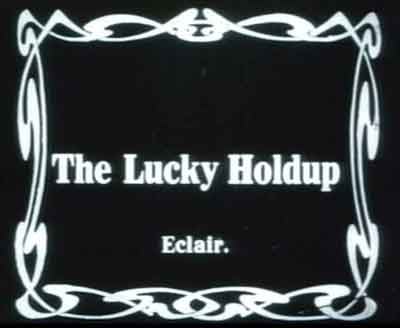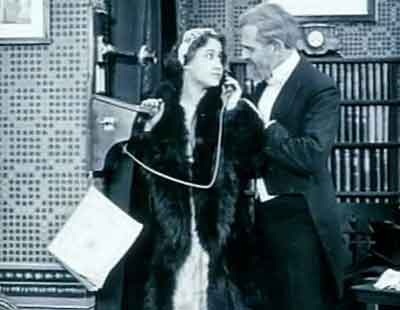Dorothy Gibson in the Éclair gangster comedy "The Lucky Holdup" (1912) in which she stars opposite Lamar Johnstone, her regular leading man. Archived at the Library of Congress, it is the only one of Dorothy Gibson's films known to exist.
This 8-minute fragment of “The Lucky Holdup,” is the only surviving film featuring silent movie star and Titanic survivor Dorothy Gibson.
The “lost film” was found by David Navone in the early 2000s in a sea chest that he bought at a California flea market and professionally restored by the American Film Institute. The original film is now safely archived for future generations at the Library of Congress.
While Dorothy Gibson’s most famous film, “Saved From the Titanic,” in which she appeared only weeks after the sinking, is no longer known to exist, “The Lucky Holdup” may be the closest that “Titanic” and film aficionados will ever get to seeing the actress in that now legendary movie.
When “The Lucky Holdup,” was first released in New York City on 11 April 1912 Dorothy was already aboard the Titanic, returning to resume her work at Éclair Film Studios after a vacation in Europe.
The movie was filmed in early March 1912. It is possible some of the dresses, coats and hats worn by Dorothy in this movie were with her when she sailed from the US and were therefore still in her luggage when she started back on the “Titanic.”
David Navone who discovered the film and kindly make it available for viewers on Encyclopedia Titanica, has produced a DVD-R of seven formerly lost films from the silent era, including “The Lucky Holdup,” which can be purchased from www.davidnavone.com.
We gratefully acknowledge the efforts of David Navone, Gregg Jasper and Randy Bryan Bigham in making this unique piece of cinema, and Titanic history available for Encyclopedia Titanica members to enjoy.
Excerpt from “Finding Dorothy: A Biography of Dorothy Gibson” about “The Lucky Holdup.”
“The Lucky Holdup,” the first of the trio of comedies Dorothy was assigned, was a frolicsome story, and ninety years later it became the first of the star’s lost films to be discovered, rescued by collectors David and Margo Navone, and preserved by the American Film Institute in cooperation with the Library of Congress Motion Picture Conservation Center. So far “The Lucky Holdup” is the only Dorothy Gibson movie known to exist, although even it isn’t completely intact, some two minutes of running time having been cut by the unknown exhibitor that once owned it. In addition, two more minutes of footage was lost during the restoration process due to deterioration.
Dorothy could never have guessed that an audience a century into the future would be served their first sampling of her celluloid self in this quaint action-adventure-comedy. Not much is known about the making of the movie, and Dorothy didn’t remember anything special about it. But to silent screen buffs there is a lot that’s special about the eight minutes that remain of “The Lucky Holdup”’s original twelve minutes of fun and suspense. The best thing is Dorothy as she smiles her adorable way through this rare one-reel treasure. “The Lucky Holdup,” as the title on the surviving print reads, was actually registered and advertised as “ALucky Hold-Up,” released April 11, just as Dorothy was heading home from her European jaunt. Billed as “The Comical Tale of Cupid’s Victory Over a Highwayman,” the story was a frenzied one.
In the movie, Miss Barton (Dorothy) and her beau Mr. Chapin (played as usual by dapper Lamar Johnstone) find themselves caught up in a feud between their affluent families. Their fathers are partners in a brokerage firm and come to blows over a deal. While at a banquet some time later, on seeing their children dancing, the embittered old men demand the young lovers end their courtship at once. The couple, refusing to do so, elopes out West to a place “in the mountains” called Bear Gulch where they’re robbed by two bandits and taken to their hideaway. The kidnapped youths convince the robbers to send a letter with a demand for money to their respective parents, who unite in a common goal to rescue their children. The old men, on arriving at Bear Gulch, are held up by the same thieves but on awarding them a $5,000 ransom, they’re reunited with their children. The closing title card reads, “All’s well that ends well.”
“The Lucky Holdup” wasn’t as widely reviewed or advertised as other Éclair films starring Dorothy, and what critical analysis it won wasn’t entirely positive. “The New York Dramatic Mirror” critic wrote that
Assuredly there is both humor and novelty in this little farce conception, and the play has been constructed to bring out the amusing complications which arise.
While “Billboard” found the conclusion effective, the “Dramatic Mirror” thought it was “not strictly American in conception.” The “Dramatic Mirror” reviewer also found the photography less than impressive and that there was a “want of spirit displayed in the actors.” Since the whole film is not extant, it’s impossible to give a thorough critique today. Many scenes are missing, including the dance sequence at the beginning and the part of the story that takes place in the thieves’ mountain cabin.
Of at least fourteen title cards describing the action, only nine are in place. More disappointingly, the surviving footage is severely deteriorated throughout. Despite the missing frames excised by an exhibitor to fit it into a tight program, and the scenes lost due to their bad condition, the film is surprisingly effective as a comedy. Filmed entirely at Fort Lee, both in town and in the surrounding woods, the movie is remarkable for the example it gives of Éclair’s reputation for ideal lighting and clear photography. It is also beautifully tinted in shades of blue, green, yellow and rose. Éclair was known for its color tinted films, and was one of the only studios in America then specializing in this artistic touch. That this is still apparent in such a ravaged print is a testament to the excellence of the restoration work done by the Triage Film Lab.
Most importantly, “The Lucky Holdup” allows fans of silent movies to acquaint themselves with the moving image of Dorothy Gibson and to judge her on-screen abilities. She doesn’t have much time to exhibit a full range of emotion in this picture, but she proves to viewers that she had a refreshingly natural method of performing. Dorothy’s mannerisms and gestures are subtle and her facial expressions, especially her rather naughty smile, are beguiling. In this movie, whatever one may think of the unfolding story, it’s a treat to witness the star’s personal magnetism at work. It’s also interesting to note her fashionable wardrobe, namely a taffeta dress with an open neck and three-quarter sleeves, a fur-trimmed velvet coat and a plumed hat. In a costuming flub common in the early silent era, Dorothy had already worn the coat and hat in at least two films; stills record them in “Divorcons” and “It Pays to be Kind.”
Probably Dorothy’s finest moment in “The Lucky Holdup” is a scene set at a bank where she and her new husband discover they’ve run out of money for their little escapade. Seated before the teller’s desk, Johnstone’s character confesses that his account is dry. Aggravated, his bride insists they must have more cash. Johnstone pulls a dollar out of his pocket, and hands it to Dorothy. His lips can be read as he says, “One!” Dorothy wears a look of disgust and her words, too, are easy to discern: “Is that all?” she asks, and leans her head sulkily on her hand. Contemporary criticism of the acting in this vehicle as lacking in spirit seems unjustified. All four principals — Dorothy, Johnstone, Guy Oliver as Dorothy’s doting father and Alec Francis as Johnstone’s ill-tempered dad — each go through their scenes with admirable restraint.
Johnstone is particularly winning as a strapping collegiate type, and Dorothy is more than convincing as his pampered wife. But it may have been the cast’s very naturalness that seemed lackluster to some critics, accustomed as they were to other players’ more “stagy” style. Additional Éclair stock members glimpsed in “The Lucky Holdup” are Jack Adolfi as a clerk, Isabel Lamon as a maid, and Julia Stuart in an unidentified role in the few seconds that remain of the party scene.
Finding Dorothy: A Biography of Dorothy Gibson by Randy Bryan Bigham
Edwardian cover girl and silent screen star Dorothy Gibson survived the Titanic, a disastrous marriage, even the horrors of a World War II concentration camp, but history didn't spare her. Randy Bryan Bigham reclaims the story of a life forgotten. Finding Dorothy, the first biography of model and actress Dorothy Gibson (1889-1946), provides an analysis of her work as the muse of artist Harrison Fisher, and offers a critique of her brief but successful career as one of the first leading ladies in American silent cinema.







Comment and discuss